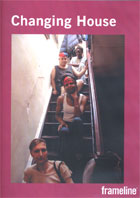
Changing House 2009
Distributed by Frameline, 145 Ninth St., Suite 300, San Francisco, CA 94103; 415-703-8650
Produced by Z.A. Martohardjono
Directed by Z.A. Martohardjono
DVD, color, 18 min.
Sr. High - Adult
Gay and Lesbian Studies, Gender Studies, Sociology
Date Entered: 08/18/2010
Reviewed by Monique Threatt, Indiana University, Herman B Wells Library, Bloomington, INZ.A. Martohardjono’s (Nomad) documentary short reveals a brief glimpse into the history of Transy House, and its founders transgender lesbian couple Rusty and Chelsea. For nearly 15 years, Rusty and Chelsea provide a safe haven for homeless straight and transgender women in the Brooklyn community. What begins as an open and welcome house for intimate friends quickly transforms into a communal home for transgender women at the request and referral of the city’s social services department. Acting as house mothers as well as therapists, Rusty and Chelsea offer advice, compassion, food, and shelter within their modest brownstone.
Transy House also quickly emerges as a place full of rich history known for its political activism and organization. As strong advocates for transgender protection rights and inclusion within gay and lesbian legislation in New York City and the greater New York State, Rusty and Chelsea’s activism leads to an encounter and long term collaboration with legendary activist Sylvia Rivera. Sylvia Rivera operates a home for transgender women, and is reportedly the first person to throw a bottle during the infamous Stone Wall Riots of 1969. Sylvia’s declining health leads her to take up residency at Transy House where she serves as a political role model and mentor until her death in 2002.
After nearly 15 years of operating Transy House, coupled with the loss of Sylvia Rivera, Rusty and Chelsea grow weary of being 24 hour housemaids. They are no longer able to sustain the energy and financial resources needed to maintain Transy House. As residents seek alternative housing, Rusty and Chelsea reflect on their accomplishments. It is clear that their unconditional love and support not only empowered residents of Transy House, but an entire transgender community.
The film includes archival footage of activist gatherings, and commentary from former residents. Anton Calderon’s musical composition is hypnotic and in stark contrast to the use of disco or House music most associated with the gay and lesbian culture. This reviewer would have liked to have seen more in-depth historical and social commentary about what it means to be a transgender, as well as a balanced perspective from those in support of, and opposed to Transy House.
Transy House is appropriate for classroom use from high school through college, and is a great addition to libraries supporting gender and sociology studies programs. I recommend the film for both academic and public libraries.